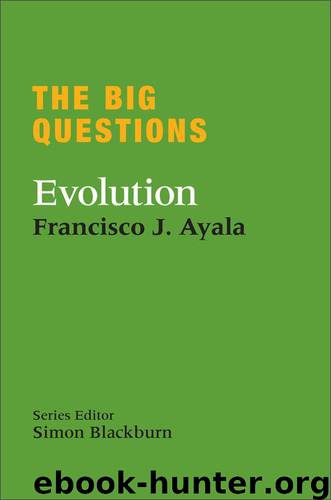The Big Questions: Evolution by Francisco Ayala

Author:Francisco Ayala
Language: eng
Format: mobi
Publisher: Quercus
Published: 2012-06-06T23:00:00+00:00
THE UNIVERSAL TREE OF LIFE, RECONSTRUCTED WITH RRNA (RIBOSOMAL NUCLEIC ACID) GENES. THE THREE MAJOR GROUPS OF ORGANISMS - BACTERIA, ARCHAEA, AND EUCARYOTA - THAT HAVE ALL EVOLVED FROM A COMMON ANCESTOR, LUCA.
Some distance methods (including the one used to construct the tree on What is Molecular Evolution?) relax the condition of uniform rate of evolution and allow for unequal rates of evolution along the branches. One of the most extensively used methods of this kind is called neighbour-joining. The method starts, as before, by identifying the smallest distance in the table and linking the two taxa involved. The next step is to remove these two taxa and calculate a new table in which their distances to other taxa are replaced by the distance between the node linking the two taxa and all other taxa. The smallest distance in this new table is used to make the next connection, which will be between two other taxa or between the previous node and a new taxon. The procedure is repeated until all taxa have been connected with one another by intervening nodes.
Parsimony methods
Maximum parsimony methods seek to reconstruct the tree that requires the fewest (i.e. the most parsimonious) number of changes summed along all branches. This is reasonable, because it will be the most likely if no other information is available. But evolution may not necessarily have occurred following a minimum path. The same change may have occurred independently along different branches, and some changes may have involved intermediate steps or back mutations.
Maximum parsimony methods are related to cladistics, a very formalistic theory of taxonomic classification, extensively used with morphological and palaeontological data. The critical feature in cladistics is the identification of derived shared traits, called synapomorphic traits. A synapomorphic trait is shared by some taxa but not others because the former inherited it from a common ancestor that acquired the trait after its lineage separated from the lineages going to the other taxa. In the evolution of carnivores, for example, domestic cats, tigers and leopards are clustered together because they possess retractable claws, a trait acquired after their common ancestor branched off from the lineage leading to the dogs, wolves and coyotes. It is important to ascertain that the shared traits are homologous rather than analogous. For example, mammals and birds, but not lizards, have a four-chambered heart. Yet birds are more closely related to lizards than to mammals; the four-chambered heart evolved independently in the bird and mammal lineages, by parallel evolution.
Maximum likelihood
Maximum likelihood methods seek to identify the most likely tree, given the available data. They require that an evolutionary model be identified that would make it possible to estimate the probability of each potential individual change. All possible trees are considered. The probabilities for each individual change are multiplied for each tree. The best tree is the one with the highest probability (or maximum likelihood) among all the trees.
Maximum likelihood methods are computationally expensive when the number of taxa is large, because the number of possible trees (for each of which the probability must be calculated) grows factorially with the number of taxa.
Download
This site does not store any files on its server. We only index and link to content provided by other sites. Please contact the content providers to delete copyright contents if any and email us, we'll remove relevant links or contents immediately.
| Fossils | Game Theory |
| Genetics | Molecular Biology |
| Organic | Paleontology |
Sapiens: A Brief History of Humankind by Yuval Noah Harari(13141)
Sapiens by Yuval Noah Harari(4596)
Homo Deus: A Brief History of Tomorrow by Yuval Noah Harari(4315)
Pale Blue Dot by Carl Sagan(4053)
Origin Story: A Big History of Everything by David Christian(3168)
Livewired by David Eagleman(3168)
Brief Answers to the Big Questions by Stephen Hawking(2903)
Inferior by Angela Saini(2856)
Origin Story by David Christian(2713)
The Evolution of Beauty by Richard O. Prum(2566)
Signature in the Cell: DNA and the Evidence for Intelligent Design by Stephen C. Meyer(2523)
The Gene: An Intimate History by Siddhartha Mukherjee(2520)
Aliens by Jim Al-Khalili(2408)
How The Mind Works by Steven Pinker(2251)
Sex at Dawn: The Prehistoric Origins of Modern Sexuality by Ryan Christopher(2163)
From Bacteria to Bach and Back by Daniel C. Dennett(2161)
A Short History of Nearly Everything by Bryson Bill(2159)
Endless Forms Most Beautiful by Sean B. Carroll(2102)
Who We Are and How We Got Here by David Reich(2077)
